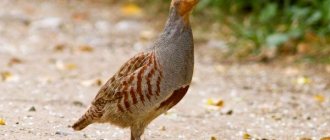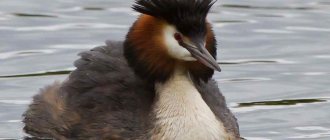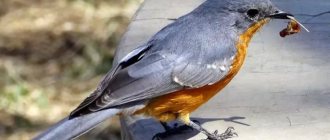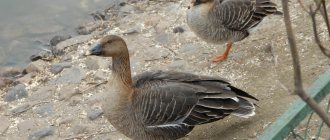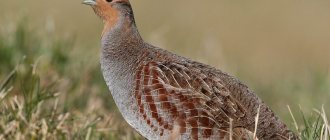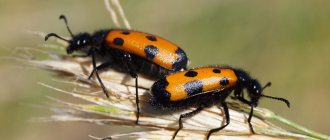The genus of ducks is diverse, but the common goldeneye is of particular interest to ornithologists. It has a diverse habitat; it differs from other duck species in its small size and rather large head. Its beak is short and its plumage is black and white.
The genus of ducks is diverse, but the common goldeneye bird is of particular interest to ornithologists
Description and features
The goldeneye bird is classified by ornithologists as wild diving ducks; it reaches a body length of 46 cm and weighs 1.1 kg; the small variety weighs no more than 450 grams, although there are also individual birds weighing 2 kg.
The stocky body of the goldeneye is distinguished by a large triangular head with a pointed crown and a sharp, high beak, wide at the base and tapering towards the tip. The neck is standard for ducks - not massive and rather short.
The color of ducks of different sexes is different: during the mating season, male goldeneye birds in the photo look as if solemn, the black plumage on the head acquires a greenish metallic sheen, and a white spot of a regular round shape appears at the base of the beak. The eyes also change - the iris becomes bright yellow, the color of the beak darkens.
The belly, sides and chest of the bird have snow-white plumage; the shoulders are decorated with a braid of alternating black and white feathers. The back, like the tail, is black, but the wings are colored black-brown. The orange legs have dark brown membranes that help the bird stand confidently on its feet.
The female is less bright: her plumage does not have a pronounced contrast, her body is gray-brown, against which a brown head and neck with a white ring of feathers stand out. The wings of males and females are almost identical, and in the summer, when males lose the brightness of their plumage, it becomes difficult to distinguish birds of different sexes.
Hunting for goldeneyes
Typically, hunting for diving ducks begins in the fall and continues until the spring, when the nesting season begins for the birds. However, the goldeneye is an exception: its meat is tasteless and smells like fish, and the weight after plucking is very small - sometimes 250-300 grams, which is why hunters do not favor the bird.
If a duck of this type is eaten, the carcass is completely cleaned of skin and subcutaneous fat, soaked in the marinade for at least a day, then stewed or fried over a fire - the eggnog soup turns out to be tasteless and very greasy.
But the down and feathers of these ducks are warm and soft, especially in the spring, which is why there are those who like to shoot goldeneyes.
Female goldeneye birds in the spring are protected from killing - hunting is allowed only for drakes, but it is forbidden to even frighten ducks, because they hatch eggs, so moving to nesting sites must take place with a sheathed gun.
Most often, decoy ducks are used to hunt goldeneye - they attract the attention of males who come out of the reed thickets and come into the view of hunters who are in boats closer to the creek.
Decoy duck
Kinds
Gogol is a rare bird, but in nature there are three types of these ducks, differing in body size:
- common is most often found in its natural habitat. The color is contrasting, differs between males and females and depends on the season: in the spring, the drake becomes brighter, thereby attracting ducks. After the mating season, he molts and becomes barely distinguishable from the female. Interestingly, some scientists distinguish two subspecies of the common goldeneye - American and Eurasian, considering the weight and size of the beak to be distinctive features. However, it is officially accepted that such differences are only the influence of environmental factors, and the species is monotypic;
- The small one is similar to an ordinary representative of the species, but is much smaller in size. The back of males is painted black, the belly and sides are snow-white, females are grayish, inconspicuous, with a brownish tint on the back;
- Icelandic is similar to the common one; birds of different sexes and ages are indistinguishable outside the mating season. With the onset of spring, the Icelander changes color: purple feathers appear on the head, and its triangular shape is even more distinguished by a white spot with rounded edges. The orange beak darkens and becomes black-brown.
Males of all species are larger than females, and the wingspan of an adult bird reaches 85 cm. Gogol floats well on the water and swims quickly, but is clumsy on land.
How to attract goldeneye ducks to nest?
Due to human activity, the population of this breed is constantly decreasing, so the issue of arranging artificial nest boxes to attract and breed birds becomes extremely relevant.
It is quite simple to build a nest box ; it consists of a box up to 60 cm high and 25 cm wide. The walls should be at least 2 cm thick, and the diameter of the taphole should be 10 cm. The bottom of the box should be covered with a thick layer of sawdust or leaves.
Photo of the nest
Such nests are also called gogolyatniks. To successfully colonize nesting boxes, they should be hung on trees near a wide body of water, and the nesting boxes should be clearly visible and noticeable to birds from the water.
Important! Catching fish using nets in reservoirs where goldeneyes live is strictly prohibited, since the birds often die after becoming entangled in the nets.
The nest boxes should be hung up before the birds return in the spring.
To better understand how successful the work was, you can keep records and record the number of hanging nests, their height, size, installation time of the nest, and distance to the reservoir.
After a certain time, statistics will make it possible to understand the preferences and needs of birds and significantly improve their nesting.
Lifestyle and habitat
Gogol is a migratory bird; it winters to the south or southwest of its nesting site, preferring the coasts of the seas or large bodies of water. But for organizing nests, ducks most often choose coniferous forests, but they can also be found in deciduous plantations in Europe and Asia; small populations live in North America.
The northwestern part of Europe has become a place of settled life for some representatives of the species. The Icelandic type of birds is located near rivers, lakes and forests of Iceland and Greenland. Individuals are found in the American northwest and Labrador.
The small goldeneye lives only in the northern part of the North American continent; in winter it moves across the mainland mainly towards Mexico. They settle around small freshwater bodies of water and avoid open areas of the tundra.
A particularly favorite place to build a nest is an old hollow in a tree trunk, which is why common people often call goldeneyes nests, but the bird does not hesitate to settle in animal burrows. Ducks can build nests at a height of up to 15 meters, but this makes it difficult for their offspring to learn.
The female defiantly descends to the ground and, remaining near the tree, calls the chicks. The little ducklings take turns jumping out of the nest and gliding on their wings, landing on a soft mat of pine needles or moss.
Gogol has an aggressive character and attacks anyone who is near the nest. During the mating season, birds communicate with each other using special calls, which are often mistaken for the squeaking of hares.
Origin story
What the breed looks like, photo:
North America is considered the birthplace of birds. However, thanks to the chronicles, it is known that even in Kievan Rus, gogols were valued for their fluff and were raised on farmland. The phraseology “walking like a gogol” was formed by comparing a person with her.
On land she moves interestingly - she throws her head back and walks slowly, as if presenting herself as a very important person.
Nutrition
The goldeneye duck is a bird of prey; its diet is based on aquatic inhabitants: small fish, crustaceans, and frogs. Ducks do not disdain insect larvae and fish fry. Hunters note that duck meat smells strongly of fish and mud.
By the way, the latter is included in the plant menu of goldeneyes, as are plants growing at the depths of the reservoir and submerged cereals, for which the bird dives into the water column. The duck is able to spend up to several minutes at a depth of 4-10 m in search of food, then floats to the surface and feasts on the finds.
Particularly rich in food are places that are often flooded with water - small depressions in the shore or areas of land near creeks - there ducks often find worms or larvae, birds do not disdain the eggs of reptiles, for example, lizards.
In the autumn, goldeneye consumes much more plant food than at other times - in this way, ducks prepare for wintering, when their diet will be represented only by mollusks and crustaceans.
Home content
At home, goldeneyes are not very common. For breeding, the common type of bird is usually used. If goldeneyes are chosen for breeding, then certain maintenance rules are followed.
Conditions of detention
Since the goldeneye is a waterfowl and an excellent diver, for comfortable keeping in captivity it must be provided with a pond near which trees grow.
In the absence of natural lakes and ponds, an artificial pond is made. But at the same time they take into account that per 1 sq. km of water no more than 3 females coexist. Otherwise, they will drive away competitors and force them out of their territory.
Nests called nests are hung on trees. They are placed at a height of more than four meters so that no one disturbs the female’s peace. The nest should be 10–14 cm high and attached with a forward slope.
The bottom is left rough so that the chicks can get out of it on their own. The entrance is made in the direction of the water. Ideally, the distance to the reservoir is no more than 10 m.
During the warm period, birds feel great in the fresh air and do not need additional room. It is enough to make a canopy that will protect them from scorching sun rays or rain.
With the onset of cold weather, the livestock is transferred to spacious poultry houses. Since wild birds tolerate cold well, no heating is required in the barn.
Simply insulating the poultry house is enough - all the cracks are caulked, a thick layer of straw bedding is placed on the floor. In the autumn-winter period, they are provided with long daylight hours of at least 14 hours using lamps.
The room is ventilated to avoid air stagnation. Regular cleaning will help prevent the spread of diseases.
Diet features
In nature, the gogol's diet consists of 70% animal and 30% plant food. In captivity they maintain the same ratio.
They are fed hard varieties of buckwheat and barley, chopped fresh fish, bloodworms and crustaceans. Be sure to organize free access to clean water, and also provide them with containers with small pebbles or granular sand.
Reproduction
Females have a strong maternal instinct and take care of their offspring independently. The most you can do to help them is to install nests. However, not all ducks like them; she herself decides where it is more comfortable for her to build a nest.
Gogol chicks grow quickly and have strong immunity.
Reproduction and lifespan
The goldeneye reaches sexual maturity at the 2nd year of life; from this moment the male begins to search for a female for reproduction. It occurs in the last weeks of winter, and in the spring the formed pair begins to search for a nesting site. It is interesting that among goldeneyes there are no fights between males for ducks; on the contrary, drakes behave like true gentlemen and “court” the females.
Mating games of goldeneyes are dances: the male throws back his head and lifts his beak, making a low squeaking sound. Matchmaking takes place on the water and is accompanied by a large amount of splashes, which form a fountain around the male and attract the female.
The duck independently arranges a nest and, after fertilization, lays 4-20 eggs there and incubates them alone: after the mating season, the male begins to change body color. The duck insulates the nest with its own feathers and down - therefore, the female hatching eggs is easily recognized by the absence of feathers on the chest and sides.
The expectant mother finds food by being distracted from hatching, but not in the last 10 days, when the duck is constantly on the eggs. It is interesting that two females can lay eggs in one nest, but they do not cooperate with each other at all - each hatches her eggs and leaves the home, regardless of the presence of the other duck there.
In total, the period between fertilization and hatching of ducklings is a month; goldeneye chicks have a black and white downy coat from birth, and 2-3 days after birth they begin to leave the nest and make their first attempts to fly.
At the age of a week, the mother takes the ducklings to a pond and teaches them to dive so that they can get food on their own. Two-month-old chicks acquire independence and are able to cover long distances, moving to the shores of large bodies of water.
Despite the fact that the goldeneye has excellent immunity, and their chicks rarely die from disease, the life expectancy of these birds is short. Under favorable climatic conditions, the duck can live 6-7 years, but long-livers have been recorded at the age of 14 years.
Lifestyle
The goldeneye's favorite habitat is quiet taiga rivers and lakes with wooded shores. In spring, these ducks arrive very early, when the reservoirs are still covered with ice, and only the first thawed patches appear. In different parts of the range this occurs from March to May. Goldeneye pairs, as a rule, form during the wintering grounds. Soon after arrival, mating displays begin. At the same time, the male spreads his tail, throws his head back, and then, with a sharp, specific cry, throws it forward and upward, raising clouds of spray with his paws.
The autumn migration of goldeneyes begins in September and ends by mid-October. They winter in the more southern parts of their range on the shores of ice-free seas or large inland bodies of water. In some places this duck is still very numerous, and it is still intensively hunted.
Interesting Facts
- The golden iris of the goldeneye's eyes, clearly visible against the background of the head color, gave the duck the name common lacewing, translated from English.
- In the 80s of the last century, the goldeneye was listed in the Red Book due to its small numbers, but its population was not only preserved, but also increased through breeding in artificially created conditions.
- Gogol is a free bird; on farms where they are bred, ducks are isolated from other birds and, if possible, the process of feeding and caring for them is automated, since birds do not like human interference in their lives, the duration of which in captivity is reduced to 5-7 years. And the maintenance of the goldeneye cannot be called simple - it needs unlimited access to water, small smooth pebbles and granular sand. Domestic ducks are fed fresh fish, special varieties of buckwheat and barley, thoroughly soaked in water.
- Newly hatched ducklings are able to jump out of the nest, located at a height of up to 15 meters, after their mother and not be harmed at all.
- Sometimes the male stays next to the nest for 5-8 days after the female lays eggs; he only protects the future offspring, but does not participate in incubation and does not bring food to the duck.
Taste qualities
Goldeneye meat has a specific swamp taste. This is the result of consuming watery foods. To remove this taste from the bird, you need to remove the fat and skin. In addition, it is recommended to soak the nog meat for 24 hours in wine vinegar.
Cooking poultry is not recommended. Its flavor is best revealed by frying and baking. The eggs of this duck have excellent taste. In some regions, people take some eggs from duck nests.
